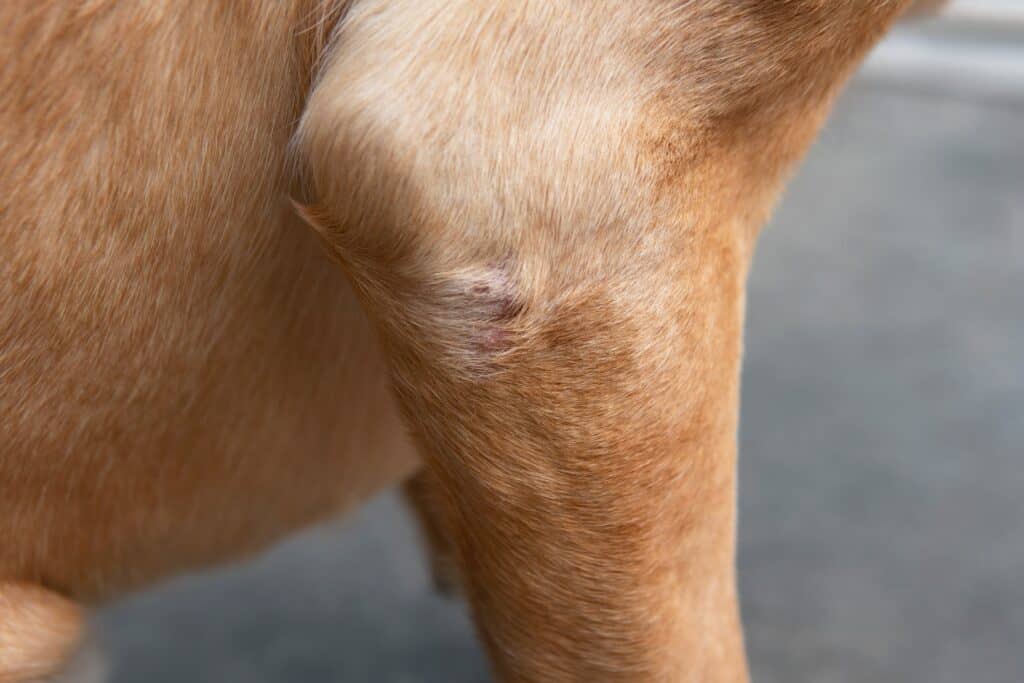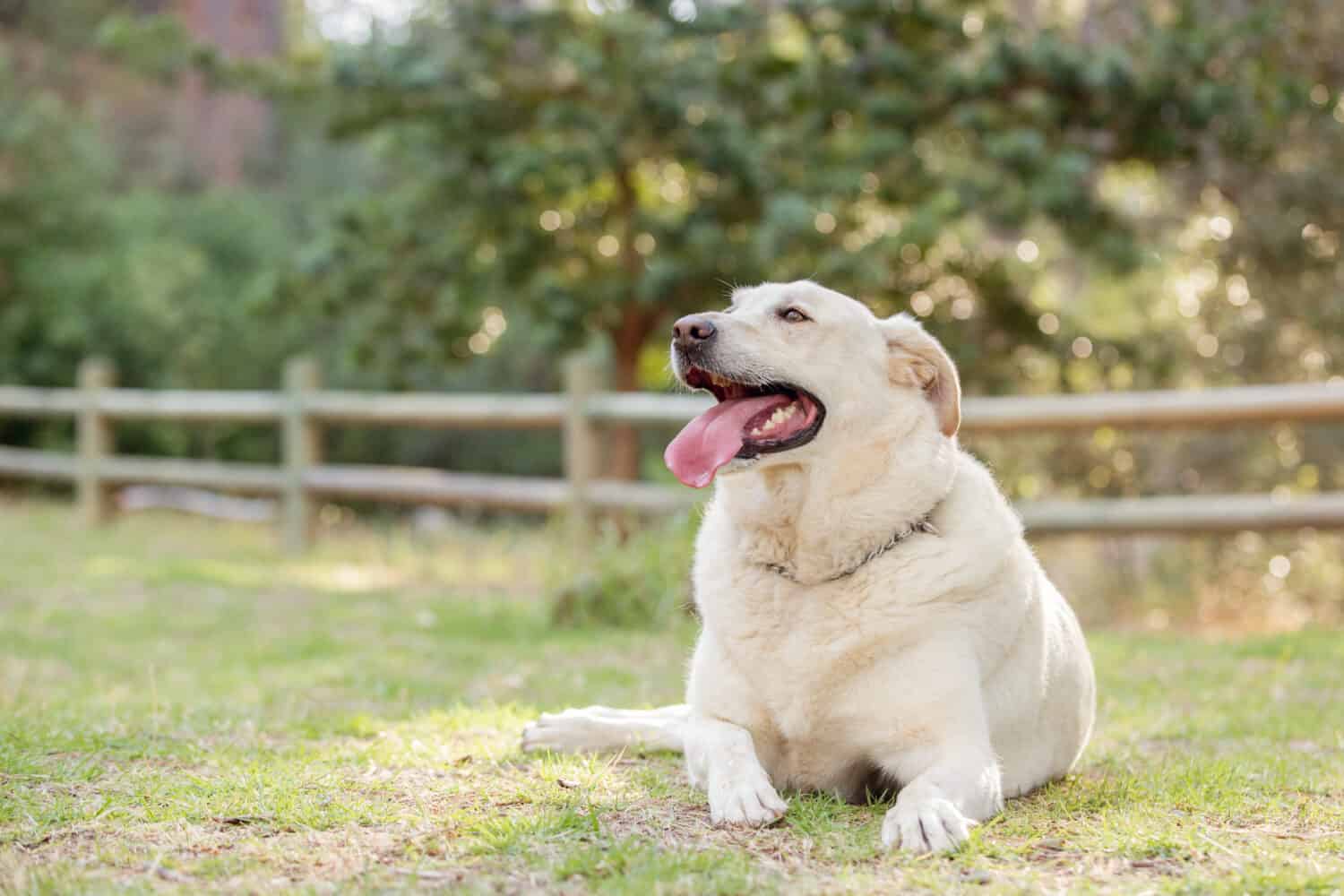The Labrador retriever stands as the champion of popularity in the U.S. In fact, Labs are the second most popular dog breed in the country. They have remained one of the most popular breeds for more than 30 years! However, these lovable dogs face a handful of common health problems that can affect their quality of life. Unfortunately, Labs have a slightly shorter lifespan than other large breeds, and there are quite a few hurdles this breed will need to jump through throughout their life. In this article, we will discuss the most common health issues encountered by Labrador retrievers.
Equipping yourself with this knowledge will help you recognize the signs early on, ensuring that your furry friend stays happy and healthy for many years.
1. Elbow Dysplasia

Around one in five labs are at high risk of developing elbow dysplasia, which causes pain and discomfort in the joints.
©9gifts/Shutterstock.com
Elbow dysplasia, specifically the occurrence of a fragmented medial coronoid process, is an unfortunate yet fairly common health issue in Labrador retrievers, with a percentage, around 17-21%, facing this condition. In this ailment, there’s an abnormal development or damage in the bone surface that constitutes the elbow joint, which can be distressing for the canine.
Various triggers can lead to this issue, including a protein-heavy diet, sudden injuries, changes in hormone levels, rapid weight gain, and the degree of physical exercise the dog undertakes.
There are a few things you can do to tackle this issue. Initially, the veterinarian might recommend drugs to ease the discomfort and lessen swelling. Closely monitoring your dog’s weight is equally important, helping to prevent extra strain on their joints. In extreme cases, your vet might propose surgery.
2. Hip Dysplasia

Hip dysplasia affects nearly one-third of all Labrador retrievers and is a common health problem in the breed.
©Jaromir Chalabala/Shutterstock.com
Labrador retrievers are unfortunately prone to another condition known as hip dysplasia, which affects approximately 31% of the breed. This abnormality occurs when the head of the femur bone doesn’t settle correctly within the hip socket, causing rather painful friction instead of a seamless glide between the joint’s components – the ball and the socket.
A crucial point to note is that hip dysplasia tends to run in families, making it a hereditary condition. This malformation, often setting the stage for arthritis as the dog ages, highlights the importance of responsible breeding practices.
Moreover, certain lifestyle factors can exacerbate this genetic tendency. Rapid growth, specific kinds of exercises, excessive weight, and insufficient nutrition can amplify the chances of developing this condition.
When managing and treating hip dysplasia in Labradors, there are several treatments to explore with your vet that will provide relief and improve the quality of life of your lab. Initially, it might involve weight management strategies to lessen the pressure on the hips. In some cases, modifying the joint fluid can also be a beneficial approach to treatment.
3. Exercised-induced Collapse (EIC)

Some Labradors have a genetic condition that can cause their hind legs to collapse during heavy exercise.
©Johanna Mehrke Fotografie/Shutterstock.com
Exercise-induced collapse (EIC) is another major health issue that affects Labrador retrievers. EIC causes an unsteady walk during physical activity or increased excitement despite appearing perfectly healthy otherwise. A majority of dogs dealing with EIC display a distinct form of collapse, which often manifests as a weakness in the hind legs. This might even progress to the point where the dogs attempt to move, yet their rear legs drag behind them.
This condition is linked to a recessive gene, implying that a dog needs to inherit two copies of this gene to show symptoms of EIC. According to data collected from 2008 to 2017, about 40% of Labrador retrievers examined were found to be carriers of this gene mutation.
Regrettably, as of now, there exists no cure or medication that can address EIC effectively. The only known strategy to manage this condition is through preventive measures. If a Labrador retriever is diagnosed with EIC, it becomes crucial to prevent them from engaging in intense physical activities or situations that could trigger extreme excitement or a “high-drive” state.
By adopting such precautionary measures, you can significantly reduce the risk of an EIC episode, helping to maintain the well-being of your beloved pet.
4. Centronuclear Myopathy

A health issue that commonly affects Labrador puppies is Centronuclear Mypothy.
©iStock.com/GlobalP
Centronuclear myopathy (CNM) is also known by several other names, including type II muscle fiber deficiency and hereditary myopathy. CNM is a concerning condition often appearing in Labrador retrievers when they are merely 2 to 5 months old. The pups affected by this condition tend to exhibit a range of symptoms, which include a reduction in muscle tone and coordination, difficulty tolerating physical activities, and an unusual way of walking.
Labrador retrievers are only affected by this disease if they receive two copies of the mutated gene, one from each parent. Unfortunately, this condition is fairly common within the breed, given the genetic predisposition.
At the moment, there isn’t a treatment available to completely cure the effects of CNM. However, there are means to ensure that the affected dogs can lead a relatively comfortable life. Providing a warm living environment and supplementing their diet with L-carnitine can offer some relief to the symptoms experienced. It is essential to differentiate CNM from exercise-induced collapse, as they have distinct clinical characteristics and require different approaches to management.
5. Epilepsy

Seizures can be a symptom of epilepsy, but luckily, treatment can help with this health issue.
©sanjagrujic/Shutterstock.com
Another common health problem in Labrador retrievers is epilepsy, an intermittent movement disorder that can cause motor seizures.
Most biologists believe this disorder to be a genetic component, as suggested by its pronounced occurrence in specific groups and its recurrent appearance across Labrador generations of the same lineage.
Typically, when initiating treatment for epilepsy, phenobarbital is the drug of choice. Though considered effective, its use can lead to a few short-term side effects in dogs, such as mild sedation. In the long run, dogs might experience other side effects of phenobarbital, such as an increased appetite and, in some cases, increased thirst and urination.
6. Shoulder Osteochondritis Dissecans

Only around 1 in 20 Labs experience Shoulder Osteochondritis Dissecans, a rare disease affecting the shoulder joint.
©Chalabala/ via Getty Images
Shoulder osteochondritis dissecans, commonly known as OCD, is a condition affecting the cartilage within the shoulder joint. This health problem results in discomfort and frequently evolves into chronic arthritis, which can be severely painful. OCD typically manifests during the initial year of a Labrador’s life, potentially causing discomfort for a few weeks or persisting throughout the dog’s lifetime.
This is a relatively rare condition that only affects around 5% of Labrador retrievers. Like many health issues on this list, scientists have traced the primary cause of OCD to genetic factors.
To manage and alleviate the pain of shoulder osteochondritis dissecans, vets often recommend surgery. This procedure involves the removal of the detached cartilage fragment, sometimes referred to as a joint mouse, which prevents them from becoming lodged elsewhere within the joint and aids in minimizing the chances of further osteoarthritis development.
7. Obesity

Nearly two-thirds of all Labrador retrievers are obese, making them one of the most obese dog breeds in the world.
©McCann Michelle/Shutterstock.com
If you know Labradors, you’d recognize their insatiable appetite, which is typical for the breed. These dogs often eat whatever they can find, and this habit can cause them to put on a lot of weight without supervision.
It’s estimated that roughly 60 percent of Labradors deal with weight issues. This makes Labradors one of the most obese dog breeds in the world.
In an in-depth study involving 310 Labradors, scientists discovered that many of these dogs lacked the entire or a portion of the POMC gene, a genetic component known to control appetite in various species. Its absence in these dogs means they are unable to recognize when they are full, leading them to consume food continuously.
Addressing the issue of obesity in Labradors involves several strategies. One primary approach is to moderately reduce their food intake and avoid fatty treats while ensuring that they engage in regular physical activities. It is important to note that extremely overweight dogs might require specialized weight loss diets.
8. Bloat

Labradors can become bloated when food or gas is trapped in their stomachs. This is likely a genetic health issue.
©Jaromir Chalabala/Shutterstock.com
Bloat is a serious medical condition that can occur in Labrador retrievers, characterized by the expansion of the stomach due to trapped food or gas, which leads to abdominal distress. The critical nature of this health problem means that it can turn fatal quickly.
While the exact origins of bloat in Labradors remain unclear, it is generally believed that a hereditary component is involved. Essentially, the likelihood of a dog experiencing bloat escalates if there is a history of the condition in the dog’s family lineage.
Unfortunately, when it comes to managing bloat, there are no home remedies or over-the-counter medications. The only effective intervention is surgical, where the stomach is decompressed and adjusted to its normal position. This procedure is time-sensitive, emphasizing the urgency to seek veterinary assistance if you suspect your dog is showing signs of bloat.
Although Labradors are not the most susceptible breed to bloat, they are still at high risk for this health problem.
9. Cancer

Another health problem that Labradors are susceptible to is cancer, specifically lymphoma.
©Zapp2Photo/Shutterstock.com
Lymphoma, also known as lymphosarcoma, is a particular form of cancer that targets Labrador retrievers more frequently than other dog breeds. This medical condition triggers the formation of abnormal lymphocytes, a variety of white blood cells. This type of cancer has the potential to manifest in various parts of the body.
Even though any dog breed can develop different forms of cancer, certain factors amplify the risk of developing tumors and cancers in canines. These include genetic predispositions and external environmental pressures.
When it comes to addressing cancer in dogs, there are several options of treatment available. These could range from surgical interventions to a combination of surgery, chemotherapy, or radiation therapy. Additionally, immunotherapy is emerging as a viable option, incorporating the use of cancer vaccines to bolster the dog’s defense against diseases like melanoma.
10. Tricuspid Valve Dysplasia (TVD)

TVD is a heart disease that can affect newborn Labrador puppies. There are treatments and drugs used to help.
©Shirebrook Photography/Shutterstock.com
Tricuspid valve dysplasia (TVD) is a heart condition where the tricuspid valve doesn’t develop correctly, resulting in blood leaking back into the heart’s right chamber. While this anomaly might occur sporadically in newborn dogs, Labrador retrievers are more prone to this health problem.
Keeping a Labrador retriever’s weight in check can significantly influence their susceptibility to various diseases, including TVD. Heart health is notably crucial, and to fend off heart diseases, it’s essential to ensure that labs maintain a balanced diet and engage in regular physical activity. By doing this, their likelihood of developing heart disease decreases substantially.
In terms of management and treatment for this condition, several treatments can be pursued to help affected dogs lead a more comfortable life. Medications are available that assist in stabilizing the heart’s functioning and normalizing the heartbeat. Additionally, drugs can be administered to prevent fluid accumulation in the lungs, a common consequence of heart disease. Surgical interventions are also a viable option, where a damaged valve may be repaired or a pacemaker installed to regulate the heart’s rhythm.
Remarkably, a quarter of the TVD cases reported are found in purebred Labrador retrievers.
How to Take Care of Your Labrador Retrievers
- Ensure regular exercise: Engage your Labrador in up to three extensive walks daily to maintain their health. Play fetching games with toys like tennis balls to keep them active and joyful.
- Maintain a balanced diet: Feed your Labrador according to its activity level, taking note of the guidelines mentioned on the food packaging. Adjust the food quantity based on their weight fluctuations. Be cautious to avoid obesity; you should be able to feel its ribs without seeing them.
- Sufficient hydration: Offer your Lab abundant fresh water, particularly post-exercise, to prevent dehydration. Allow them to regulate their own water intake.
- Grooming and Health: Brush your Lab weekly during summer months to get rid of loose fur and promote a healthy coat. Keep a check on their dental health to prevent various tooth diseases. Make regular vet visits for vaccinations and address potential health concerns.
- Training and Socialization: Educate your Lab with basic commands like “sit”, “stay”, and “come” to foster a safer and more confident pet. Prioritize positive reinforcement over punishment to build a trusting relationship. Introduce your Labrador to various environments and people, encouraging gentle interactions to develop their social skills.
Remember, continuous learning and training can potentially prolong their lifespan.
Summary of Common Health Problems Seen in Labrador Retrievers
| Health Problem | Symptoms |
|---|---|
| Elbow Dysplasia | Swollen elbow and reluctance to exercise or play |
| Hip Dysplasia | Decreased activity and reluctance to jump, run, or climb |
| Exercise-induced Collapse | Wobbly walk and collapse starting with rear limb weakness |
| Centronuclear Myopathy | Loss of muscle tone, awkward gait, and exercise intolerance |
| Epilepsy | Collapsing, loss of consciousness, loss of bowel control, and uncontrollable muscle activity |
| Shoulder Osteochondritis Dissecans | Reluctance to exercise or play, lameness, joint pain or swelling, stiffness, or general depression. |
| Obesity | Bigger face, excessive panting, reluctance to walk, and abdominal sagging |
| Bloat | Hard belly, panting, restlessness, drooling, and retching but not able to vomit |
| Cancer | Unusual bumps and lumps, wounds that don’t heal, and weight loss |
| Tricuspid Valve Dysplasia | Rapid heartbeat, weakness, fatigue, and exercise intolerance |
The photo featured at the top of this post is © McCann Michelle/Shutterstock.com
Ready to discover the top 10 cutest dog breeds in the entire world?
How about the fastest dogs, the largest dogs and those that are -- quite frankly -- just the kindest dogs on the planet? Each day, AZ Animals sends out lists just like this to our thousands of email subscribers. And the best part? It's FREE. Join today by entering your email below.
Thank you for reading! Have some feedback for us? Contact the AZ Animals editorial team.






